KwaZulu-Natal Herbarium
Euphorbia grandidens Haw.
Family:
Common names: valleybush euphorbia, large-toothed euphorbia (Eng.); valleibosnaboom, groottandnaboom (Afr.); umhlontlo (isiXhosa); umhlonhlo wehlathi (isiZulu)
SA Tree No: 350
Plant Attributes:
Plant Type:
SA Distribution:
Soil type:
Flowering season:
PH:
Flower colour:
Aspect:
Gardening skill:
Special Features:
Horticultural zones
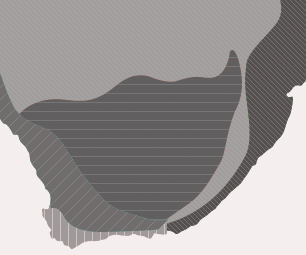
Vepris carringtoniana Mendonça
Family:
Common names: winged white-ironwood; coastal white-ironwood (Eng.); vlerksteelwitysterhout, kuswitysterhout (Afr.), umozane (isiZulu)
SA Tree No: 261.1
Plant Attributes:
Plant Type:
SA Distribution:
Soil type:
Flowering season:
PH:
Flower colour:
Aspect:
Gardening skill:
Special Features:
Horticultural zones

Vepris reflexa I.Verd.
Family:
Common names: bushveld white-ironwood (Eng.); bosveldwitysterhout (Afr.); umozane (isiZulu)
SA Tree No: 260
Plant Attributes:
Plant Type:
SA Distribution:
Soil type:
Flowering season:
PH:
Flower colour:
Aspect:
Gardening skill:
Special Features:
Horticultural zones

Asparagus virgatus Baker
Family:
Common names: broom asparagus, slender asparagus, ‘Tiki’ fern, African broom fern (Eng.); makkatdoring, katstertjie (Afr.); ibutha, ihabiya, iphinganhloya, unwele (isiZulu)
Plant Attributes:
Plant Type:
SA Distribution:
Soil type:
Flowering season:
PH:
Flower colour:
Aspect:
Gardening skill:
Special Features:
Horticultural zones

Coleotrype natalensis C.B.Clarke
Family:
Common names: none recorded
Plant Attributes:
Plant Type:
SA Distribution:
Soil type:
Flowering season:
PH:
Flower colour:
Aspect:
Gardening skill:
Special Features:
Horticultural zones

Isolepis R.Br.
Family:
Common names: Sedges (Eng); madzhesi (Tshivenda)
Species
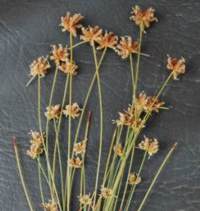
Isolepis antarctica (L.) Roem. & Schult.
Isolepis antarctica is an annual of about 80 to 200 mm tall, with numerous straw-coloured and dark red spikelets that consist of an indeterminate rachilla with many, spirally arranged glumes, with each glume subtending a bisexual flower. Its subtending glumes develop slowly and older glumes grow into a bonnet-like shape, protecting the fruit. It is widely distributed in damp flats and slopes up to 800 m altitude, from the Cape Peninsula to Langeberg Mountains in the Western Cape. It flowers between October to November.
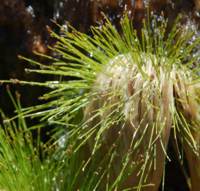
Isolepis digitata Schrad.
Isolepis digitata is a tufted perennial of about 150 to 200 mm tall, with green spikelets. It is commonly found attached to rocks in streams, below 1 000 m altitude, between Clanwilliam and Riversdale in the Western Cape. It flowers between September and January.
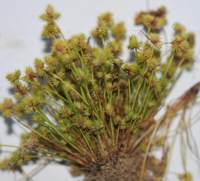
Isolepis hystrix (Thunb.) Nees
Isolepis hystrix is a small, densely tufted, annual species about 20 to 100 mm tall, with green spikelets. It is usually found in damp flats, and sometimes at altitudes of about 1 600 m. It is widely distributed from Namaqualand to the Cape Peninsula. This species flowers between August and November.
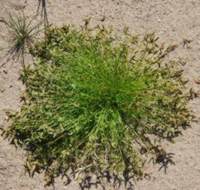
Isolepis levynsiana Muasya & D.A.Simpson
Isolepis levynsiana is a tufted annual up to 150 mm tall, with inflorescence and spikelets that are green or reddish, flattened with a distichous glume arrangement. It is widely distributed on lower mountain slopes, extending from Namaqualand in the Northern Cape to the Eastern Cape. Its flowers between September and January.
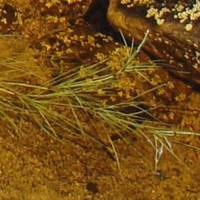
Isolepis striata (Nees) Kunth
Isolepis striata extends from Namaqualand to Riviersonderend to Uitenhage in the Eastern Cape, growing in pools at lower altitudes. It is a branched aquatic perennial with green or reddish terminal spikelets and glumes from 3.5 to 4.5 mm long. There are three involucral bracts that are shorter than the spikelets. The species flowers between August and December.
Plant Attributes:
Plant Type:
SA Distribution:
Soil type:
Flowering season:
PH:
Flower colour:
Aspect:
Gardening skill:
Special Features:
Horticultural zones

Ziziphus mucronata Willd. subsp. mucronata
Family:
Common names: buffalo thorn (Eng.); blinkblaar-wag-'n-bietjie (Afr.); umphafa, umlahlankosi, isilahla (isiZulu); umphafa (isiXhosa); umlahlabantu (Swazi); mokgalo (Tswana); mutshetshete (Venda); mphasamhala (Tsonga); mokgalô, moonaona (N Sotho)
SA Tree No: 447
Plant Attributes:
Plant Type:
SA Distribution:
Soil type:
Flowering season:
PH:
Flower colour:
Aspect:
Gardening skill:
Special Features:
Horticultural zones

Zantedeschia Spreng.
Family:
Common names: arum lilies, calla lilies, pig lily (Eng.); varkblom (Afr.)
Species
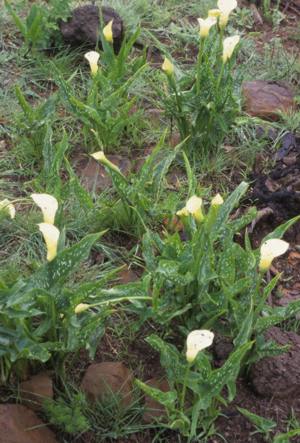
albomaculata (Hook.) Baill.
Common names: Arrow-leaved arum, spotted-leaved arum (Eng.); kleinvarkoor, witvlekvarkoor (Afr.); mohalalitoe (South Sotho); intebe (Xhosa, Zulu), ilabatheka-elimhlophe (Zulu), ilabatheka-omhlophe (Zulu). These are deciduous, medium to tall plants up to 0.7 m high, growing in small clumps. They have oblong or triangular arrow-shaped leaves, often speckled with white spots. Spathes are cylindrical, white, cream or pale yellow and frequently dark purple at the base within.
subsp. albomaculata
Leaves oblong, spathe tapering to apex, berries many, medium-sized, up to 18 mm in diameter. It flowers October to April. The subspecies occurs in the Eastern Cape, KwaZulu-Natal, Lesotho, Free State, Swaziland, Mpumalanga and Limpopo. It also extends into Zimbabwe, Malawi, Zambia, Angola and Tanzania. It is found along rocky hillsides, forest margins and stream banks.
subsp. macrocarpa (Engl.) Letty
Leaves triangular, spathe shortened at apex, berries few, large, mostly close to 20 mm in diameter. It flowers from November to April with a peak in December. The subspecies occurs in KwaZulu-Natal, Lesotho, Free State, Swaziland, Mpumalanga and Gauteng. It grows in grassy vleis and marshy ground beside streams.

Zantedeschia elliotiana (Watson) Engl.
These are deciduous, medium to tall plants up to 0.6 m high, growing singly or forming small clumps. Their leaves are large, broadly ovate, deep green and speckled with white spots. The spathe is a cup-shaped funnel, bright golden-yellow and dark purple at the base within. It flowers November to January.
The species is known only from cultivated specimens and has not been found in the wild. It is probably a hybrid of garden origin. Suspected parents include Z. pentlandii or Z. jucunda and Z. albomaculata subsp. albomaculata.
Zantedeschia odorata P.L.Perry
These are deciduous, medium to tall plants up to 0.75 m high. Their leaves are broadly ovate and not speckled. Spathes are cylindrical and white. They flower in late July and August.
Z. odorata is restricted to an area known as Klip Koppies at Nieuwoudtville in the Northern Cape. The outcrops are formed by large dolerite boulders which break down to form a red clay soil which retains water well in the rainy season. The plants grow in crevices between the boulders, where at least the lower part of the plant is in cool shade. The roots are in seasonally very wet soil or sometimes in standing water.
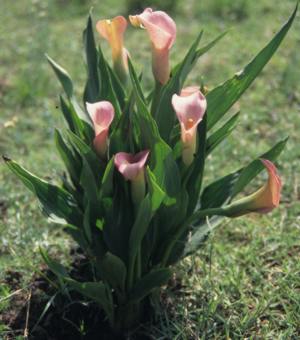
Zantedeschia rehmannii Engl.
These are small to medium plants 0.2–0.6 m high. Their leaves are lance-shaped, dark green and very rarely speckled with white spots. The spathes are cylindrical, colour ranging from white through shades of pink to dark maroon (almost black). They flower September to February, with a peak in November to January.
Z. rehmannii occurs from Harrismith in the Free State and northern KwaZulu-Natal, through Swaziland to Mpumalanga. This species grows among rocks on grassy hillsides at medium and quite high altitudes, in semi-shade at forest margins and in sandy furrows.
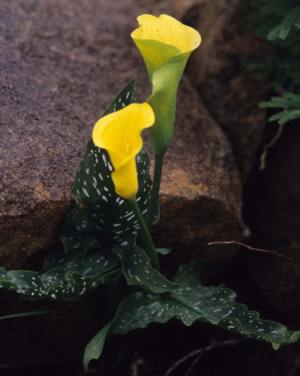
Zantedeschia jucunda Letty
Common name: magapule (Pedi)
These are deciduous, medium to tall plants, up to 0,8 m high, growing solitary or in small clumps. Their leaves are triangular-hastate, deep green and speckled with white spots. The spathe is a cup-shaped funnel, deep or cream-yellow and dark purple at the base within. They flower from November to January.
Z. jucunda is confined to the summit of the Leolo Mountains in the Sekhukuneland Centre of Floristic Endemism. This species grows on grassy slopes, among rocks in full sun.

Zantedeschia pentlandii (Watson) Wittm.
Common name: Mapoch lily
These are deciduous, medium to tall plants, up to 0.6 m tall. Leaves broadly ovate, glaucous green and very rarely speckled with white spots. The spathe is a cup-shaped funnel, lemon-chrome yellow and dark purple at the base within. They flower from November to December.
The species is restricted to the Mapoch region of Mpumalanga, comprising the northern part of the Belfast District and adjoining parts of the Lydenburg District. Plants often grow in dense colonies wedged between rocks. Tubers are relatively superficial and plants can be dug out easily.
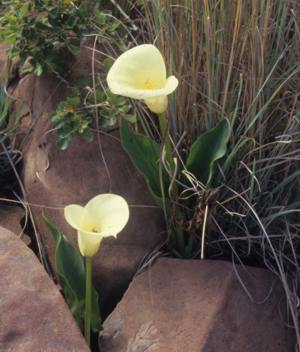
Zantedeschia valida (Letty) Y.Singh
These are deciduous, robust plants, up to 0.75 m tall. Leaves broadly ovate, plain, not speckled or very speckled with white spots. The spathe is a cup-shaped funnel dark purple at the base within. They flower from October to March with the peak in November.
The species is restricted to the region bordered by the Biggarsberg, Giants Castle and Collin's Pass in KwaZulu-Natal. Plants grow among rocks on the mountains in clefts and on foothills, as well as on the banks of streams and in vleis.
Plant Attributes:
Plant Type:
SA Distribution:
Soil type:
Flowering season:
PH:
Flower colour:
Aspect:
Gardening skill:
Special Features:
Horticultural zones

Xylotheca kraussiana Hochst.
Family:
Common names: African dog rose (Eng.); umbalekani, isishwashwa (Zulu); umdubu (Xhosa); Afrikaanse hondsroos (Afr.)
SA Tree No: 493
Plant Attributes:
Plant Type:
SA Distribution:
Soil type:
Flowering season:
PH:
Flower colour:
Aspect:
Gardening skill:
Special Features:
Horticultural zones

Watsonia latifolia N.E.Br. ex Oberm
Family:
Common names: broad-leaved watsonia (Eng.); sidvwa (siSwati)
Plant Attributes:
Plant Type:
SA Distribution:
Soil type:
Flowering season:
PH:
Flower colour:
Aspect:
Gardening skill:
Special Features:
Horticultural zones






Rate this article
Article well written and informative
Rate this plant
Is this an interesting plant?
Login to add your Comment
Back to topNot registered yet? Click here to register.